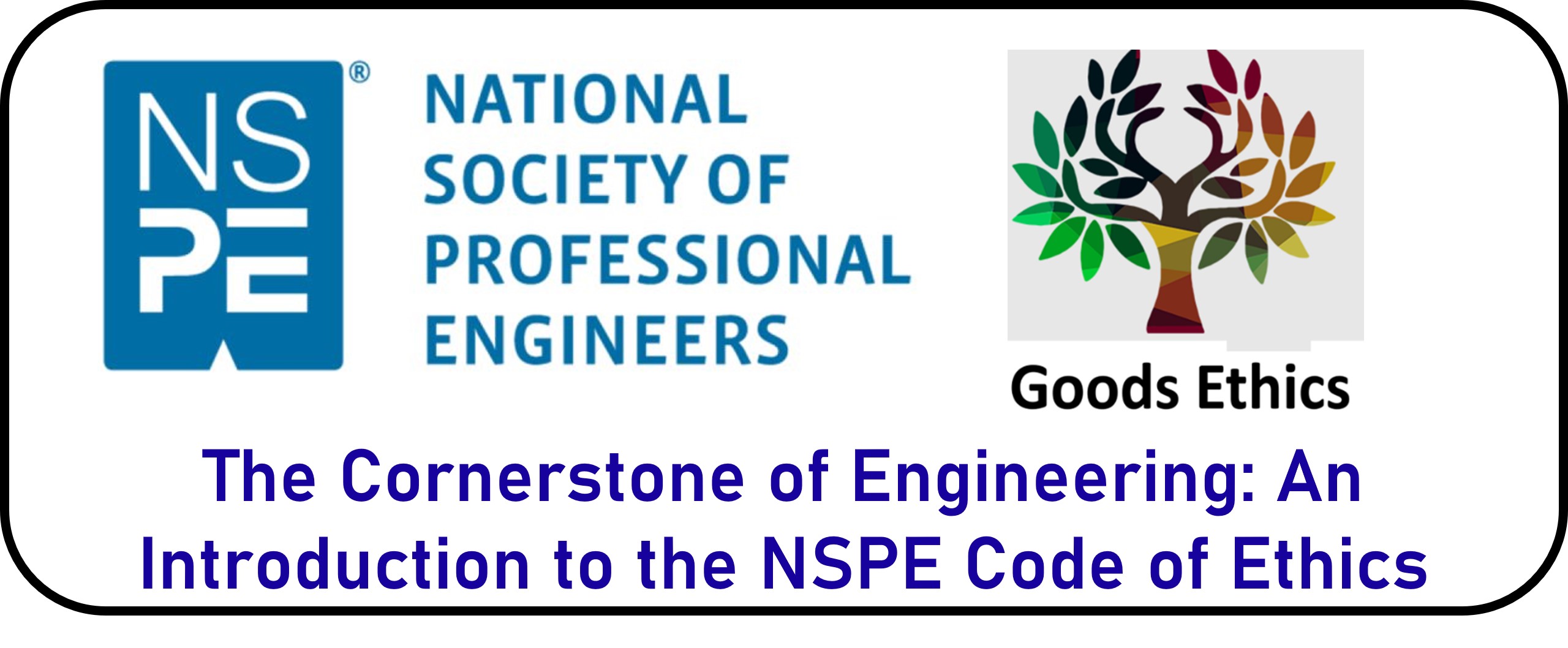In the vast expanse of human history, few professions have shaped the trajectory of civilization as profoundly as engineering. From the aqueducts of ancient Rome to the hyperloops of the modern age, engineers have been at the forefront of innovation, turning the impossible into the tangible.
But in this relentless pursuit of progress, a pivotal question emerges: In a world where technology and innovation drive change, where does ethics fit in the life of an engineer?
The answer lies in the heart of the engineering profession itself. Just as a bridge relies on its foundational pillars, the integrity of the engineering profession rests on its ethical foundation.
This foundation is encapsulated in the National Society of Professional Engineers (NSPE) Code of Ethics, a beacon guiding engineers in their professional conduct. Let’s explore their code of ethics and how it applies to modern day engineering.
Overview of the NSPE Code of Ethics: A Guiding Light in the Engineering Landscape
As I delved deeper into the engineering profession, I quickly realized that our work is not just about calculations, designs, and innovations. At its core, engineering is about trust.
The public places immense trust in us, believing that the bridges they cross, the buildings they inhabit, and the technologies they use are safe and reliable. And how do we, as engineers, ensure we’re worthy of this trust? We turn to the NSPE Code of Ethics.
Origins of the Code: The NSPE Code of Ethics wasn’t born overnight. It’s a product of years of reflection, lessons learned from past mistakes, and a collective desire to elevate the profession. Think of the Tacoma Narrows Bridge collapse in 1940 or the Hyatt Regency walkway failure in 1981. These engineering disasters underscored the dire need for a unified ethical code to guide our profession.
Purpose of the Code
The NSPE Code serves multiple purposes:
- A Standard for Professional Behavior: It’s our North Star, guiding us in our professional decisions and actions.
- Protection of Public Welfare: The Code emphasizes the safety, health, and welfare of the public, reminding us of our primary duty.
- Promotion of Honesty and Integrity: It instills in us the values of truthfulness and honor, ensuring we remain trustworthy in the eyes of the public and our peers.
Structure of the Code
The Code is meticulously structured into three main sections, each addressing a distinct aspect of our professional responsibilities:
- Fundamental Canons: These are the bedrock principles of our profession. For instance, the canon that emphasizes holding “paramount the safety, health, and welfare of the public” is a constant reminder that our work has real-world implications. A poorly designed infrastructure can risk lives, while a well-executed project can enhance the quality of life for countless individuals.
- Rules of Practice: This section delves deeper into the practical application of the canons, offering specific guidelines. For example, it advises against revealing confidential information without consent, a principle I’ve found crucial when working with proprietary technologies or sensitive projects.
- Professional Obligations: Here, the Code speaks to our broader responsibilities, not just to our clients or employers, but to society at large. It reminds us to acknowledge our errors, to continue our professional development, and to always strive to serve the public interest.
The Importance of Ethics in Engineering: More Than Just Numbers and Designs
When I first embarked on my engineering journey, I was enamored by the world of equations, blueprints, and groundbreaking innovations. But as I delved deeper, I realized that the true essence of engineering transcends beyond these technicalities. It’s rooted in ethics.
The very fabric of our profession is interwoven with moral principles and ethical considerations. But why is ethics so pivotal in engineering?
Historical Context
History is replete with examples that underscore the profound importance of ethics in our field. Consider the following:
| Engineering Disaster | Year | Key Ethical Oversight |
| Tacoma Narrows Bridge Collapse | 1940 | Ignoring the effects of aerodynamic flutter. |
| Challenger Space Shuttle Disaster | 1986 | Overlooking concerns about the O-ring seals in cold temperatures. |
| Bhopal Gas Tragedy | 1984 | Negligence in maintaining safety standards for hazardous materials. |
Each of these tragedies wasn’t just a technical failure; it was an ethical lapse. Lives were lost, and communities were shattered, underscoring the dire consequences of sidelining ethics.
Modern Relevance
In today’s rapidly evolving technological landscape, the ethical stakes are even higher. We’re not just building bridges or skyscrapers; we’re developing AI systems, biotechnologies, and digital infrastructures that have profound societal implications. For instance:
- AI Ethics: As I’ve ventured into projects involving artificial intelligence, I’ve grappled with questions like: “Is this AI system biased?” or “Could this technology infringe on individual privacy?”
- Environmental Considerations: In our quest for innovation, are we overlooking the environmental footprint? Sustainable engineering isn’t just a buzzword; it’s an ethical imperative.
- Data Privacy: In an era of big data, ensuring the privacy and security of user information is paramount. It’s not just about compliance; it’s about upholding trust.
The Ethical Backbone
Ethics is the backbone of engineering. It’s what differentiates a mere technical expert from a responsible engineer. Every line we draw, every code we write, and every structure we build carries with it an ethical responsibility. It’s a weighty obligation, but it’s also a privilege. It’s what makes our profession truly noble.
As I reflect on my engineering journey, I’m constantly reminded that our work is not just about creating; it’s about caring. It’s about ensuring that every innovation, every design, and every project is underpinned by a steadfast commitment to ethics.
Real-World Implications: When Ethics Meets Reality
Throughout my engineering journey, I’ve often been struck by a profound realization: the decisions we make, the designs we draft, and the solutions we implement don’t exist in a vacuum. They ripple out into the real world, impacting lives, societies, and the environment.
Let’s delve into some tangible outcomes that arise when we either uphold or neglect the principles of the NSPE Code of Ethics.
Public Safety and Trust
- Upholding Ethics: When we prioritize the safety, health, and welfare of the public, as the NSPE Code of Ethics mandates, we not only prevent potential disasters but also foster a deep sense of trust. I recall working on a bridge project where rigorous safety checks, though time-consuming, ensured the structure’s longevity and reliability.
- Neglecting Ethics: On the flip side, cutting corners can lead to catastrophic failures. The collapse of the Morandi Bridge in Italy in 2018 is a grim reminder of the consequences of overlooking regular maintenance and safety checks.
Innovation with Responsibility
- Upholding Ethics: As engineers, we’re at the forefront of innovation. But with great power comes great responsibility. When developing a new AI system, for instance, ensuring it’s free from biases and respects user privacy can lead to technology that truly benefits society.
- Neglecting Ethics: Conversely, unchecked innovations can have dire consequences. The ethical concerns surrounding deepfake technologies, which can manipulate videos to depict false realities, are a testament to the dangers of innovation without oversight.
Environmental Stewardship
- Upholding Ethics: Sustainable engineering is not just a trend; it’s an ethical duty. By integrating eco-friendly materials and energy-efficient designs, we can create projects that harmonize with the environment. A solar-powered housing project I was involved in not only reduced energy costs but also minimized carbon footprints.
- Neglecting Ethics: Ignoring environmental considerations can lead to devastating impacts. The widespread deforestation for urban development, without sustainable planning, has exacerbated climate change and led to loss of biodiversity.
Professional Growth and Reputation
- Upholding Ethics: Adhering to ethical guidelines enhances our professional reputation. It opens doors to collaborations, fosters trust with clients, and paves the way for career growth. I’ve found that clients often prefer working with engineers known for their ethical standards.
- Neglecting Ethics: Ethical lapses can tarnish our reputation, lead to legal repercussions, and even end careers. Cases of plagiarism, data falsification, or conflicts of interest can irreparably damage an engineer’s standing in the community.
Community and Societal Impact
- Upholding Ethics: When we engage in projects with a community-first approach, we can drive positive societal change. Infrastructure projects that prioritize local needs, for instance, can uplift entire communities, providing them with better access to amenities and opportunities.
- Neglecting Ethics: Overlooking community needs can lead to projects that, while technically sound, fail to resonate with the people they’re meant to serve. I’ve seen mega-projects that, due to lack of community consultation, remained underutilized or even faced backlash.
Final Takeaway
In the grand tapestry of engineering, ethics is the thread that binds us to the real world. It’s the bridge between our technical expertise and the tangible impacts we create. As I navigate the multifaceted challenges of modern engineering, I’m constantly reminded of the profound implications of our work. It’s a weighty responsibility, but it’s also what makes our profession so incredibly rewarding.

